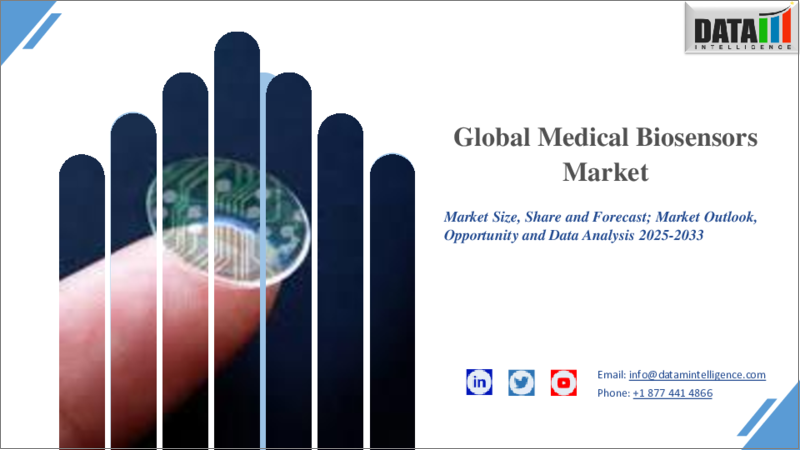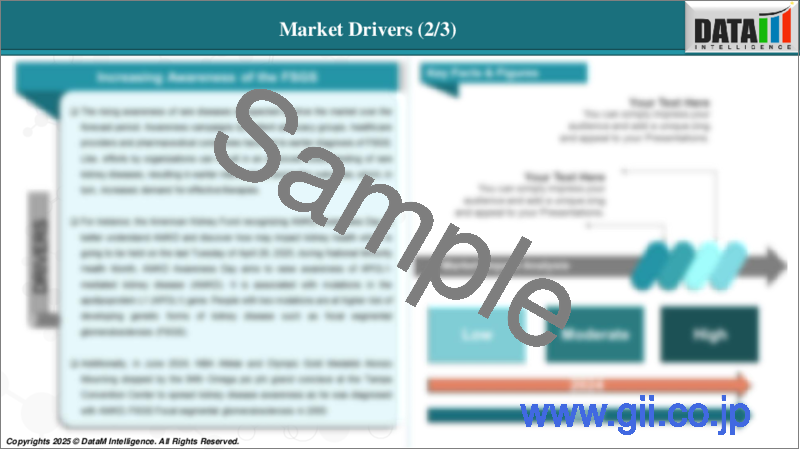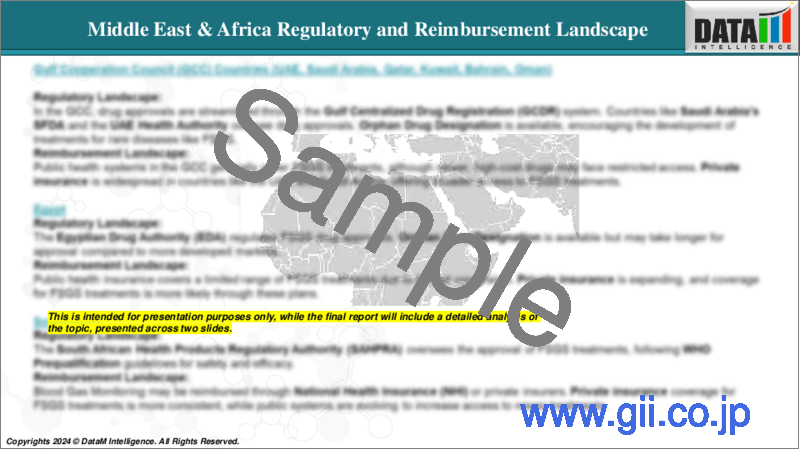|
|
市場調査レポート
商品コード
1606542
医療用バイオセンサーの世界市場-2024~2031年Global Medical biosensors market - 2024-2031 |
||||||
カスタマイズ可能
適宜更新あり
|
|||||||
| 医療用バイオセンサーの世界市場-2024~2031年 |
|
出版日: 2024年12月04日
発行: DataM Intelligence
ページ情報: 英文 176 Pages
納期: 即日から翌営業日
|
- 全表示
- 概要
- 目次
概要
世界の医療用バイオセンサー市場は、2023年に56億5,000万米ドルに達し、2031年には109億米ドルに達し、予測期間2024-2031年のCAGRは8.5%で成長すると予測されています。
バイオセンサーは、センサーシステムとトランスデューサーのような生物学的検出要素を組み合わせ、生物学的反応を電気信号に変換する分析装置です。検査される被分析物と通信し、その反応をトランスデューサで電気信号に変換することで機能します。医療用バイオセンサーは、生物学的分子、組織、生物を利用するため、リアルタイムの検出課題に独自に適しており、医療診断や患者モニタリングにおいて重要な役割を果たしています。グルコースバイオセンサーは、糖尿病診断の臨床アプリケーションに広く使用されており、世界市場の85%を占めています。バイオセンサー分野は、免疫センサーやサーマルバイオセンサーなど様々なタイプに拡大している:促進要因と阻害要因
技術進歩の台頭
技術の進歩は、これらのデバイスの精度、機能性、アクセシビリティを向上させることで、世界の医療用バイオセンサー市場の成長を促進しています。ナノテクノロジーの革新はバイオセンサーの感度と特異性を高め、病気の早期診断を可能にしています。人工知能と機械学習アルゴリズムは、バイオセンサーをスマートな診断ツールへと変貌させ、リアルタイムのデータ分析、予測的洞察、個別化された健康推奨を提供しています。
フレキシブルでウェアラブルなバイオセンサーは、その用途を臨床環境以外にも広げ、継続的な健康モニタリングや遠隔患者ケアを可能にしています。BluetoothやNFCのような無線通信技術は、バイオセンサーとデジタルヘルスプラットフォーム間のシームレスな接続を可能にしました。小型化と生体適合性材料により、バイオセンサーはより使いやすくなり、現代のヘルスケア・システムに不可欠なツールとなっています。
例えば、STマイクロエレクトロニクスは2024年10月、スマートウォッチ、スポーツバンド、コネクテッドリング、スマートグラスなどのヘルスケア用ウェアラブル向けに、新しい医療用バイオセンシングチップST1VAFE3BXを発表しました。このチップは、高精度の生体電位入力と慣性センシングを使用しており、低消費電力でより高速なパフォーマンスを実現します。STのバイオセンサーは、胸部バンドや小型パッチでのECG解析を含む、精密なアスリート・パフォーマンス・モニタリング・システムの開発を可能にしました。vAFEからのアナログ信号と加速度センサからのモーション・データをコンパクトなパッケージで組み合わせることにより、正確でコンテキストを考慮したデータ解析が可能になり、センサ上で直接AIアルゴリズムをサポートします。
精度と信頼性の限界
バイオセンサーは大きく進歩したが、様々な条件下で精度と信頼性を維持する能力は常に課題でした。このような変化には、環境条件、ユーザーのばらつき、センサーの劣化などが含まれます。これらの要因はすべてデバイスの性能に影響するため、誤った測定値につながります。糖尿病管理におけるグルコース・モニタリングのようなヘルスケア・アプリケーションの重要な分野では、わずかな不正確さが命取りになることさえあります。このような高品質の性能と信頼性は、通常、高度な技術と頻繁な校正を必要とし、コストとメンテナンス要件を増加させる。このようなことから、現在進行中の市場では、多くのアプリケーションで精度と信頼性のためにバイオセンサーの使用が制限されています。
目次
第1章 調査手法と調査範囲
第2章 定義と概要
第3章 エグゼクティブサマリー
第4章 市場力学
- 影響要因
- 促進要因
- 技術進歩の高まり
- 促進要因
- 抑制要因
- 精度と信頼性の制限
- 機会
- 影響分析
第5章 産業分析
- ポーターのファイブフォース分析
- サプライチェーン分析
- 価格分析
- 規制分析
第6章 製品タイプ別
- ウェアラブルバイオセンサー
- 非ウェアラブルバイオセンサー
第7章 用途別
- 診断
- 監視
- 治療
- 患者モニタリング
- ホームケア
第8章 技術別
- 電気化学バイオセンサー
- 光学バイオセンサー
- 熱バイオセンサー
- 圧電バイオセンサー
第9章 エンドユーザー別
- 病院と診療所
- 在宅ヘルスケア
- 研究室
- 外来手術センター
第10章 地域別
- 北米
- 米国
- カナダ
- メキシコ
- 欧州
- ドイツ
- 英国
- フランス
- スペイン
- イタリア
- その他欧州地域
- 南米
- ブラジル
- アルゼンチン
- その他南米
- アジア太平洋地域
- 中国
- インド
- 日本
- 韓国
- その他アジア太平洋地域
- 中東・アフリカ
第11章 競合情勢
- 競合シナリオ
- 市況・シェア分析
- M&A分析
第12章 企業プロファイル
- Abbott Laboratories
- 会社概要
- 製品ポートフォリオと概要
- 財務概要
- 主な発展
- Bio-Rad Laboratories Inc
- Biosensors International Group, Ltd
- DuPont Biosensor Materials
- Ercon, Inc
- Johnson & Johnson
- Koninklijke Philips N.V
- LifeScan, Inc
- Medtronic
- Molex LLC(LIST NOT EXHAUSTIVE)
第13章 付録
Overview
The global medical biosensors market reached US$ 5.65 billion in 2023 and is expected to reach US$ 10.90 billion by 2031, growing at a CAGR of 8.5% during the forecast period 2024-2031.
A biosensor is an analytical device that combines biological detecting elements like a sensor system and a transducer to convert a biological response into an electrical signal. It works by communicating with the analyte being tested and converting the response into an electrical signal by the transducer. Medical biosensors play a significant role in medical diagnostics and patient monitoring, as they are uniquely suited to real-time detection challenges due to their use of biological molecules, tissues, and organisms. Glucose biosensors are widely used in clinical applications for diabetes diagnosis, accounting for 85% of the world market. The biosensor field has expanded into various types, including immunosensors and thermal biosensors.Market Dynamics: Drivers & Restraints
Rise in the Technological Advancements
Technological advancements are driving the growth of the global medical biosensors market by improving the precision, functionality, and accessibility of these devices. Nanotechnology innovations have enhanced the sensitivity and specificity of biosensors, enabling early disease diagnosis. Artificial intelligence and machine learning algorithms have transformed biosensors into smart diagnostic tools, providing real-time data analysis, predictive insights, and personalized health recommendations.
Flexible and wearable biosensors have expanded their applications beyond clinical settings, enabling continuous health monitoring and remote patient care. Wireless communication technologies like Bluetooth and NFC have enabled seamless connectivity between biosensors and digital health platforms. Miniaturization and biocompatible materials have made biosensors more user-friendly, making them indispensable tools in modern healthcare systems.
For instance, in October 2024, STMicroelectronics has introduced a new medical bio-sensing chip, the ST1VAFE3BX, for healthcare wearables like smart watches, sports bands, connected rings, and smart glasses. The chip uses high-accuracy biopotential input and inertial sensing, ensuring faster performance with lower power consumption.ST's biosensor has enabled the development of precise athlete performance monitoring systems, including ECG analysis in chest bands or small patches. The combination of analog signal from the vAFE with motion data from the acceleration sensor in a compact package allows for precise and context-aware data analysis, supporting AI algorithms directly on the sensor.
Accuracy and Reliability Limitations
Although biosensors have advanced significantly, the ability to maintain accuracy and reliability under varying conditions has always been a challenge. Such variation includes environmental conditions, user variability, and sensor deterioration. All these factors affect the performance of the device and thus lead to misleading readings. In critical areas of healthcare applications, such as glucose monitoring in diabetic management, slight inaccuracies can even be fatal. Such high-quality performance and dependability usually require advanced technology and frequent calibrations, which increase costs and maintenance requirements. With these, many applications restrict the usability of biosensors for accuracy and reliability in the ongoing market.
Segment Analysis
The global medical biosensors market is segmented based on product type, application, technology, end user and region.
Product type:
Wearable Biosensors segment is expected to dominate the medical biosensors market share
The wearable biosensors segment holds a major portion of the medical biosensors market share and is expected to continue to hold a significant portion of the medical biosensors market share during the forecast period.
Wearable biosensors are revolutionizing the medical biosensors market by providing real-time health monitoring and diagnostic capabilities in a non-invasive manner. These devices, such as smartwatches, patches, and fitness bands, measure biomarkers like glucose levels, heart rate, blood pressure, and oxygen saturation. The rise in chronic diseases and demand for personalized medicine has driven the adoption of wearable biosensors. They are also used in remote patient monitoring, telehealth applications, and fitness tracking, especially during the COVID-19 pandemic. Advancements in sensor miniaturization, wireless connectivity, and AI-driven platforms are expected to further enhance the adoption and functionality of wearable biosensors, expanding their role in modern healthcare.
For instance, in June 2024, Trinity Biotech, a biotechnology company specializing in human diagnostics and diabetes management solutions, has launched its continuous glucose monitoring (CGM) microsite. The site will provide stakeholders with insights into the company's vision for the next generation of its CGM biosensor technology and AI-driven health analytics platform, as well as international commercialization of these solutions.
Application:
Diagnostics segment is the fastest-growing segment in medical biosensors market share
The diagnostics segment is the fastest-growing segment in the medical biosensors market share and is expected to hold the market share over the forecast period.
Diagnostics are a crucial segment of the global medical biosensors market, utilizing biosensor technology for accurate, rapid, and sensitive disease detection. These sensors are increasingly used in point-of-care diagnostics for conditions like diabetes, infectious diseases, cancer, and cardiovascular ailments, offering convenience and speed over traditional laboratory methods. They detect specific biological markers through electrochemical, optical, and piezoelectric methods, ensuring high precision and reliability. Advancements in portable and miniaturized biosensors have extended their use into home diagnostics, empowering individuals to self-monitor their health and reducing healthcare facility burden. The growing focus on personalized and preventive medicine and increasing incidence of chronic and infectious diseases highlight the importance of diagnostics in the biosensors market.
Geographical Analysis
North America is expected to hold a significant position in the medical biosensors market share
North America holds a substantial position in the medical biosensors market and is expected to hold most of the market share due to well-established healthcare infrastructure, advanced technological capabilities, and willingness to adopt innovative medical devices. In the U.S., chronic diseases have a higher prevalence, creating enormous opportunities for biosensors in hospitals or home care. Moreover, investments in healthcare research and reimbursement policies promote the exceptional adoption of biosensors for diagnosis and monitoring. Further, the contributions of Canada towards North America's market growth are significant; it is rapidly adopting wearable biosensors in its elderly population.
For instance, in November 2024, A new variant of human mpox has claimed the lives of 5% of people with reported infections in the Democratic Republic of the Congo since 2023, many of them children. The outbreak has spread to several other countries, leading to the World Health Organization declaring it a Public Health Emergency of International Concern. A different, rarely fatal mpox variant has caused an outbreak in over 100 countries since 2022. Researchers from the University of California School of Medicine and Boston University have developed an optical biosensor that can rapidly detect monkeypox, the virus that causes mpox, allowing clinicians to diagnose the disease at the point of care.
Moreover, in November 2023, A Malmo University researcher has developed a wireless biosensor that allows early detection of infections through smart catheters, diapers, or wound dressings. The technology has potential applications in health monitoring and disease monitoring. However, it requires reliable, user-friendly sensors that don't require traditional integrated circuits or bulky batteries.
Europe is growing at the fastest pace in the medical biosensors market
Europe holds the fastest pace in the medical biosensors market and is expected to hold most of the market share due to its robust healthcare infrastructure, increasing prevalence of chronic diseases, and strong government support for innovative medical technologies. The aging population in Europe is driving demand for advanced diagnostic and monitoring devices, particularly wearable devices, for real-time health monitoring. The region's emphasis on personalized and preventive healthcare has accelerated the adoption of biosensors, particularly wearable devices. Europe is also investing in research and development, supported by regulatory frameworks and initiatives like the European Union's Horizon programs. The COVID-19 pandemic has further boosted demand for biosensors in home diagnostics and point-of-care applications. Technological advancements, including nanotechnology and AI, and IoT-enabled medical devices are also driving the market.
For instance, in October 2024, Bruker Corporation has acquired Dynamic Biosensors GmbH, a Munich-based biosensor development company, strengthening its biophysical portfolio for molecular interaction and kinetic analysis. Dynamic Biosensors offers deep insights into inter-molecular and molecule-single cell interactions, supporting drug discovery in pharma, biotech, and basic research.
Competitive Landscape
The major global players in the medical biosensors market include Abbott Laboratories, Bio-Rad Laboratories Inc, Biosensors International Group, Ltd, DuPont Biosensor Materials, Ercon, Inc, Johnson & Johnson, Koninklijke Philips N.V, LifeScan, Inc Medtronic, Molex LLC among others.
Emerging Players
The emerging players in the medical biosensors market include Biolinq, Nemaura Medical, GlySens Incorporated and among others
Key Developments
- In August 2024, Metropolis Healthcare Limited has launched two advanced diagnostic laboratories in Telangana, Warangal and Nizamabad, as part of its strategic plan to improve diagnostic services in Tier 2 and Tier 3 cities. The facilities, covering 1,200 sq. ft., can process over 15,000 samples per month and offer a range of tests from basic pathology to advanced molecular diagnostics. By integrating state-of-the-art technology, Metropolis aims to strengthen local healthcare infrastructure and increase access to high-quality diagnostics for residents in these regions.
- In October 2024, The Saudi Food and Drug Authority (SFDA) has launched an initiative to develop diagnostic laboratory equipment and advance 3D printing in hospitals. The initiative aims to foster innovation, research, and development while reducing costs for hospitals and medical laboratories. The equipment and reagents are provided for diagnostic and therapeutic use within hospitals and are not intended for commercial purposes. The initiative aligns with the SFDA's commitment to encouraging innovators, supporting national industries, and empowering investors regarding products under its oversight.
- In October 2024, The Krishna Institute of Medical Sciences (KIMS) has signed a memorandum of understanding (MoU) with Wipro GE Healthcare to procure medical technology and services worth up to Rs 700 crore. The MoU covers new products, replacements, and sewices for 12 KIMS hospitals and 4 upcoming hospitals over the next three years. The MoU covers a full suite of medical technology products designed by Wipro GE Healthcare.
Why Purchase the Report?
- Pipeline & Innovations: Insights into clinical trials, product pipelines, and upcoming advancements.
- Market Positioning: Analysis of product performance and growth potential for optimized strategies.
- Real-World Evidence: Integration of patient feedback for enhanced product outcomes.
- Physician Preferences: Insights into healthcare provider behaviors and adoption strategies.
- Regulatory & Market Updates: Coverage of recent regulations, policies, and emerging technologies.
- Competitive Insights: Analysis of market share, competitor strategies, and new entrants.
- Pricing & Market Access: Review of pricing models, reimbursement trends, and access strategies.
- Market Expansion: Strategies for entering new markets and forming partnerships.
- Regional Opportunities: Identification of high-growth regions and investment prospects.
- Supply Chain Optimization: Assessment of risks and distribution strategies.
- Sustainability & Regulation: Focus on eco-friendly practices and regulatory changes.
- Post-Market Surveillance: Enhanced safety and access through post-market data.
- Value-Based Pricing: Insights into pharmacoeconomics and data-driven R&D decisions.
The global medical biosensors market report delivers a detailed analysis with 60+ key tables, more than 50 visually impactful figures, and 176 pages of expert insights, providing a complete view of the market landscape.
Target Audience 2023
- Manufacturers: Pharmaceutical, Medical Device, Biotech Companies, Contract Manufacturers, Distributors, Hospitals.
- Regulatory & Policy: Compliance Officers, Government, Health Economists, Market Access Specialists.
- Technology & Innovation: AI/Robotics Providers, R&D Professionals, Clinical Trial Managers, Pharmacovigilance Experts.
- Investors: Healthcare Investors, Venture Fund Investors, Pharma Marketing & Sales.
- Consulting & Advisory: Healthcare Consultants, Industry Associations, Analysts.
- Supply Chain: Distribution and Supply Chain Managers.
- Consumers & Advocacy: Patients, Advocacy Groups, Insurance Companies.
- Academic & Research: Academic Institutions.
Table of Contents
1. Methodology and Scope
- 1.1. Research Methodology
- 1.2. Research Objective and Scope of the Report
2. Definition and Overview
3. Executive Summary
- 3.1. Snippet by Product Type
- 3.2. Snippet by Application
- 3.3. Snippet by Technology
- 3.4. Snippet by End User
- 3.5. Snippet by Region
4. Dynamics
- 4.1. Impacting Factors
- 4.1.1. Drivers
- 4.1.1.1. Rise in the Technological Advancements
- 4.1.1. Drivers
- 4.2. Restraints
- 4.2.1. Accuracy and Reliability Limitations
- 4.3. Opportunity
- 4.3.1. Impact Analysis
5. Industry Analysis
- 5.1. Porter's Five Force Analysis
- 5.2. Supply Chain Analysis
- 5.3. Pricing Analysis
- 5.4. Regulatory Analysis
6. By Product type
- 6.1. Introduction
- 6.1.1. Market Size Analysis and Y-o-Y Growth Analysis (%), By Product type
- 6.1.2. Market Attractiveness Index, By Product type
- 6.2. Wearable Biosensors*
- 6.2.1. Introduction
- 6.2.2. Market Size Analysis and Y-o-Y Growth Analysis (%)
- 6.3. Non-Wearable Biosensors
7. By Application
- 7.1. Introduction
- 7.1.1. Market Size Analysis and Y-o-Y Growth Analysis (%), By Application
- 7.1.2. Market Attractiveness Index, By Application
- 7.2. Diagnostics*
- 7.2.1. Introduction
- 7.2.2. Market Size Analysis and Y-o-Y Growth Analysis (%)
- 7.3. Monitoring
- 7.4. Therapeutics
- 7.5. Patient Monitoring
- 7.6. Home Care
8. By Technology
- 8.1. Introduction
- 8.1.1. Market Size Analysis and Y-o-Y Growth Analysis (%), By Technology
- 8.1.2. Market Attractiveness Index, By Technology
- 8.2. Electrochemical Biosensors*
- 8.2.1. Introduction
- 8.2.2. Market Size Analysis and Y-o-Y Growth Analysis (%)
- 8.3. Optical Biosensors
- 8.4. Thermal Biosensors
- 8.5. Piezoelectric Biosensors
9. By End User
- 9.1. Introduction
- 9.1.1. Market Size Analysis and Y-o-Y Growth Analysis (%), By End User
- 9.1.2. Market Attractiveness Index, By End User
- 9.2. Hospitals and Clinics*
- 9.2.1. Introduction
- 9.2.2. Market Size Analysis and Y-o-Y Growth Analysis (%)
- 9.3. Home Healthcare
- 9.4. Research Laboratories
- 9.5. Ambulatory Surgical Centers
10. By Region
- 10.1. Introduction
- 10.1.1. Market Size Analysis and Y-o-Y Growth Analysis (%), By Region
- 10.1.2. Market Attractiveness Index, By Region
- 10.2. North America
- 10.2.1. Introduction
- 10.2.2. Key Region-Specific Dynamics
- 10.2.3. Market Size Analysis and Y-o-Y Growth Analysis (%), By Product Type
- 10.2.4. Market Size Analysis and Y-o-Y Growth Analysis (%), By Application
- 10.2.5. Market Size Analysis and Y-o-Y Growth Analysis (%), By Technology
- 10.2.6. Market Size Analysis and Y-o-Y Growth Analysis (%), By End User
- 10.2.7. Market Size Analysis and Y-o-Y Growth Analysis (%), By Country
- 10.2.7.1. U.S.
- 10.2.7.2. Canada
- 10.2.7.3. Mexico
- 10.3. Europe
- 10.3.1. Introduction
- 10.3.2. Key Region-Specific Dynamics
- 10.3.3. Market Size Analysis and Y-o-Y Growth Analysis (%), By Product Type
- 10.3.4. Market Size Analysis and Y-o-Y Growth Analysis (%), By Application
- 10.3.5. Market Size Analysis and Y-o-Y Growth Analysis (%), By Technology
- 10.3.6. Market Size Analysis and Y-o-Y Growth Analysis (%), By End User
- 10.3.7. Market Size Analysis and Y-o-Y Growth Analysis (%), By Country
- 10.3.7.1. Germany
- 10.3.7.2. U.K.
- 10.3.7.3. France
- 10.3.7.4. Spain
- 10.3.7.5. Italy
- 10.3.7.6. Rest of Europe
- 10.4. South America
- 10.4.1. Introduction
- 10.4.2. Key Region-Specific Dynamics
- 10.4.3. Market Size Analysis and Y-o-Y Growth Analysis (%), By Product Type
- 10.4.4. Market Size Analysis and Y-o-Y Growth Analysis (%), By Application
- 10.4.5. Market Size Analysis and Y-o-Y Growth Analysis (%), By Technology
- 10.4.6. Market Size Analysis and Y-o-Y Growth Analysis (%), By End User
- 10.4.7. Market Size Analysis and Y-o-Y Growth Analysis (%), By Country
- 10.4.7.1. Brazil
- 10.4.7.2. Argentina
- 10.4.7.3. Rest of South America
- 10.5. Asia-Pacific
- 10.5.1. Introduction
- 10.5.2. Key Region-Specific Dynamics
- 10.5.3. Market Size Analysis and Y-o-Y Growth Analysis (%), By Product Type
- 10.5.4. Market Size Analysis and Y-o-Y Growth Analysis (%), By Application
- 10.5.5. Market Size Analysis and Y-o-Y Growth Analysis (%), By Technology
- 10.5.6. Market Size Analysis and Y-o-Y Growth Analysis (%), By End User
- 10.5.7. Market Size Analysis and Y-o-Y Growth Analysis (%), By Country
- 10.5.7.1. China
- 10.5.7.2. India
- 10.5.7.3. Japan
- 10.5.7.4. South Korea
- 10.5.7.5. Rest of Asia-Pacific
- 10.6. Middle East and Africa
- 10.6.1. Introduction
- 10.6.2. Key Region-Specific Dynamics
- 10.6.3. Market Size Analysis and Y-o-Y Growth Analysis (%), By Product Type
- 10.6.4. Market Size Analysis and Y-o-Y Growth Analysis (%), By Application
- 10.6.5. Market Size Analysis and Y-o-Y Growth Analysis (%), By Technology
- 10.6.6. Market Size Analysis and Y-o-Y Growth Analysis (%), By End User
11. Competitive Landscape
- 11.1. Competitive Scenario
- 11.2. Market Positioning/Share Analysis
- 11.3. Mergers and Acquisitions Analysis
12. Company Profiles
- 12.1. Abbott Laboratories*
- 12.1.1. Company Overview
- 12.1.2. Product Portfolio and Description
- 12.1.3. Financial Overview
- 12.1.4. Key Developments
- 12.2. Bio-Rad Laboratories Inc
- 12.3. Biosensors International Group, Ltd
- 12.4. DuPont Biosensor Materials
- 12.5. Ercon, Inc
- 12.6. Johnson & Johnson
- 12.7. Koninklijke Philips N.V
- 12.8. LifeScan, Inc
- 12.9. Medtronic
- 12.10. Molex LLC (LIST NOT EXHAUSTIVE)
13. Appendix
- 13.1. About Us and Services
- 13.2. Contact Us






